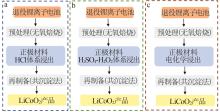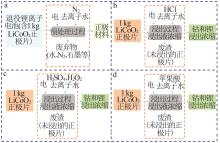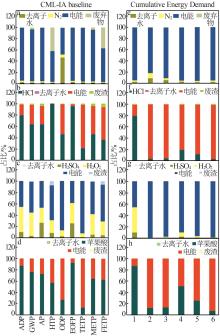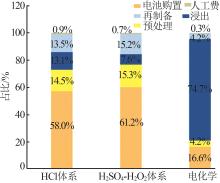| 1 |
KIM T, SONG Wentao, SON D Y, et al. Lithium-ion batteries:Outlook on present,future,and hybridized technologies[J].Journal of Materials Chemistry A, 2019, 7(7):2942-2964.
|
| 2 |
GU Fu, GUO Jianfeng, YAO Xing, et al. An investigation of the current status of recycling spent lithium-ion batteries from consumer electronics in China[J].Journal of Cleaner Production, 2017, 161:765-780.
|
| 3 |
YAN Zhiliang, HU Qiyang, YAN Guochun, et al. Co3O4/Co nano-particles enclosed graphitic carbon as anode material for high performance Li-ion batteries[J].Chemical Engineering Journal, 2017, 321:495-501.
|
| 4 |
LI Guangzhe, HUANG Bin, PAN Zhefei, et al. Advances in three-dimensional graphene-based materials:Configurations,preparation and application in secondary metal(Li,Na,K,Mg,Al)-ion batteries[J].Energy & Environmental Science, 2019, 12(7):2030-2053.
|
| 5 |
LIU Dandan, SU Zhi, WANG Lei. Pyrometallurgically regenerated LiMn2O4 cathode scrap material and its electrochemical properti-es[J].Ceramics International, 2021, 47(1):42-47.
|
| 6 |
XIAO Hougui, JI Guanjun, YE Long, et al. Efficient regeneration and reutilization of degraded graphite as advanced anode for lithium-ion batteries[J].Journal of Alloys and Compounds, 2021, 888.Doi:10.1016/j.jallcom.2021.161593.
doi: 10.1016/j.jallcom.2021.161593
|
| 7 |
MAKUZA B, TIAN Qinghua, GUO Xueyi, et al. Pyrometallurgical options for recycling spent lithium-ion batteries:A comprehensive review[J].Journal of Power Sources, 2021, 491.Doi:10.1016/j.jpowsour.2021.229622.
doi: 10.1016/j.jpowsour.2021.229622
|
| 8 |
YANG Yue, HUANG Guoyong, XU Shengming, et al. Thermal treatment process for the recovery of valuable metals from spent lithium-ion batteries[J].Hydrometallurgy, 2016, 165:390-396.
|
| 9 |
HUANG Bin, PAN Zhefei, SU Xiangyu, et al. Recycling of lithium-ion batteries:Recent advances and perspectives[J].Journal of Power Sources, 2018, 399:274-286.
|
| 10 |
RAJ T, CHANDRASEKHAR K, KUMAR A N, et al. Recycling of cathode material from spent lithium-ion batteries:Challenges and future perspectives[J].Journal of Hazardous Materials, 2022, 429.Doi:10.1016/j.jhazmat.2022.128312.
doi: 10.1016/j.jhazmat.2022.128312
|
| 11 |
HARPER G, SOMMERVILLE R, KENDRICK E, et al. Recycling lithium-ion batteries from electric vehicles[J].Nature, 2019, 575(7781):75-86.
|
| 12 |
MROZIK W, RAJAEIFAR M A, HEIDRICH O, et al. Environmental impacts,pollution sources and pathways of spent lithium-ion batteries[J].Energy & Environmental Science, 2021, 14(12):6099-6121.
|
| 13 |
SINGH U K, KUMAR B. Pathways of heavy metals contamination and associated human health risk in Ajay River Basin,India[J].Chemosphere, 2017, 174:183-199.
|
| 14 |
SHI Yang, CHEN Gen, CHEN Zheng. Effective regeneration of LiCoO2 from spent lithium-ion batteries:A direct approach towards high-performance active particles[J].Green Chemistry, 2018, 20(4):851-862.
|
| 15 |
李惜. 健全废旧锂离子电池回收利用支撑体系[N].中国矿业报, 2022-03-12(4).
|
| 16 |
SHIBAZAKI K, AZUMA D, WATANABE M, et al. Hydrothermal organic acid leaching of positive electrode material of lithium-ion batteries[J].Kagaku Kogaku Ronbunshu, 2020, 46(5):167-175.
|
| 17 |
LI Jishen, YANG Xiyun, YIN Zhoulan. Recovery of manganese from sulfuric acid leaching liquor of spent lithium-ion batteries and synthesis of lithium ion-sieve[J].Journal of Environmental Chemical Engineering, 2018, 6(5):6407-6413.
|
| 18 |
CHEN Mengyuan, MA Xiaotu, CHEN Bin, et al. Recycling end-of-life electric vehicle lithium-ion batteries[J].Joule, 2019, 3(11):2622-2646.
|
| 19 |
PETERS J F, BAUMANN M, ZIMMERMANN B, et al. The environmental impact of Li-ion batteries and the role of key parame-ters-A review[J].Renewable and Sustainable Energy Reviews, 2017, 67:491-506.
|
| 20 |
LYBBERT M, GHAEMI Z, BALAJI A K, et al. Integrating life cycle assessment and electrochemical modeling to study the effects of cell design and operating conditions on the environmental impacts of lithium-ion batteries[J].Renewable and Sustainable Energy Reviews, 2021, 144.Doi:10.1016/j.rser.2021.111004.
doi: 10.1016/j.rser.2021.111004
|
| 21 |
REY I, VALLEJO C, SANTIAGO G, et al. Environmental impacts of graphite recycling from spent lithium-ion batteries based on life cycle assessment[J].ACS Sustainable Chemistry & Engineering, 2021, 9(43):14488-14501.
|
| 22 |
JIANG Songyan, HUA Hui, ZHANG Ling, et al. Environmental impacts of hydrometallurgical recycling and reusing for manufacturing of lithium-ion traction batteries in China[J].Science of the Total Environment, 2022, 811.Doi:10.1016/j.scitotenv.2021.152224.
doi: 10.1016/j.scitotenv.2021.152224
|
| 23 |
GAINES L. Lithium-ion battery recycling processes:Research towards a sustainable course[J].Sustainable Materials and Technologies, 2018, 17.Doi:10.1016/j.susmat.2018.e00068.
doi: 10.1016/j.susmat.2018.e00068
|
| 24 |
HE Lipo, SUN Shuying, SONG Xingfu, et al. Recovery of cathode materials and Al from spent lithium-ion batteries by ultrasonic cleaning[J].Waste Management, 2015, 46:523-528.
|
| 25 |
GAO Wenfang, ZHANG Xihua, ZHENG Xiaohong, et al. Lithium carbonate recovery from cathode scrap of spent lithium-ion battery:A closed-loop process[J].Environmental Science & Technology, 2017, 51(3):1662-1669.
|
| 26 |
LI Jia, WANG Guangxu, XU Zhenming. Environmentally-friendly oxygen-free roasting/wet magnetic separation technology for in situ recycling cobalt,lithium carbonate and graphite from spent LiCoO2/graphite lithium batteries[J].Journal of Hazardous Materials, 2016, 302:97-104.
|
| 27 |
DUAN Xiaowei, ZHU Wenkun, RUAN Zhongkui, et al. Recycling of lithium batteries-A review[J].Energies, 2022, 15(5).Doi:10.3390/en15051611.
doi: 10.3390/en15051611
|
| 28 |
YAO Yonglin, ZHU Meiying, ZHAO Zhuo, et al. Hydrometallurgical processes for recycling spent lithium-ion batteries:A critical review[J].ACS Sustainable Chemistry & Engineering, 2018, 6(11):13611-13627.
|
| 29 |
Jung J C Y, Chow N, Warkentin D D, et al. Experimental study on recycling of spent lithium-ion battery cathode materials[J].Journal of the Electrochemical Society, 2020, 167(16).Doi:10.1149/1945-7111/abd600.
doi: 10.1149/1945-7111/abd600
|
| 30 |
LI Jinhui, SHI Pixing, WANG Zefeng, et al. A combined recovery process of metals in spent lithium-ion batteries[J].Chemosphere, 2009, 77(8):1132-1136.
|
| 31 |
SHIN S M, KIM N H, SOHN J S, et al. Development of a metal recovery process from Li-ion battery wastes[J].Hydrometallurgy, 2005, 79(3/4):172-181.
|
| 32 |
MENG Qi, ZHANG Yingjie, DONG Peng. Use of electrochemical cathode-reduction method for leaching of cobalt from spent lithi-um-ion batteries[J].Journal of Cleaner Production, 2018, 180:64-70.
|
| 33 |
杨海波, 梁辉, 黄继承, 等. 从废旧锂离子电池中回收制备LiCoO2的结构与性能研究[J].稀有金属材料与工程, 2006, 35(5):836-840.
|
|
YANG Haibo, LIANG Hui, HUANG Jicheng, et al. Research on structure and properties of LiCoO2 prepared from spent lithium ion batteries[J].Rare Metal Materials and Engineering, 2006, 35(5):836-840.
|
| 34 |
气体网. 多因素提振 2021年中国液氮价格震荡上扬[EB/OL].(2022-01-17)[2022-10-03].
|
| 35 |
北极星储能网. 7月12日储能材料价格:钴酸锂价格下跌 5 000元/吨![EB/OL].(2022-07-12)[2022-10-03].
|
| 36 |
陈雨康. 中国硫酸工业协会:预计硫酸价格将高位运行[EB/OL].(2022-07-20)[2022-10-03].
|
| 37 |
吴小龙, 王晨麟, 陈曦, 等. 废旧锂离子电池市场规模及回收利用技术[J].环境科学与技术, 2020, 43(S2):179-183.
|
|
WU Xiaolong, WANG Chenlin, CHEN Xi, et al. Market scale and recycling technology of waste lithium-ion batteries[J].Environmental Science & Technology, 2020, 43(S2):179-183.
|
| 38 |
YANG Jingbo, FAN Ersha, LIN Jiao, et al. Recovery and reuse of anode graphite from spent lithium-ion batteries via citric acid leaching[J].ACS Applied Energy Materials, 2021, 4(6):6261-6268.
|
| 39 |
NATARAJAN S, ARAVINDAN V. An urgent call to spent LIB recycling:Whys and wherefores for graphite recovery[J].Advanced Energy Materials, 2020, 10(37).Doi:10.1002/aenm.202002238.
doi: 10.1002/aenm.202002238
|
| 40 |
FAN Ersha, LI Li, WANG Zhenpo, et al. Sustainable recycling technology for Li-ion batteries and beyond:Challenges and future prospects[J].Chemical Reviews, 2020, 120(14):7020-7063.
|
| 41 |
刘东旭, 蔡牧涯, 陈翔, 等. 废旧锂离子电池负极材料再生和利用进展[J].化学工业与工程, 2021, 38(6):2-12.
|
|
LIU Dongxu, CAI Muya, CHEN Xiang, et al. Progress on regeneration and reutilization of anode materials from spent lithium-ion batteries[J].Chemical Industry and Engineering, 2021, 38(6):2-12.
|
 ),HE Ting1,2,FU Tongtong1,2,GUO Zirui1,2,GU Shuai1,2(
),HE Ting1,2,FU Tongtong1,2,GUO Zirui1,2,GU Shuai1,2( ),YU Jianguo1,2(
),YU Jianguo1,2( )
)







